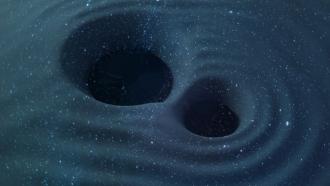
Photo: Vignesh Kamat / Research Matters
On February 11, 2016, The Laser Interferometer Gravitational-wave Observatory (LIGO) and Virgo observatory announced the detection of a gravitational wave for the first time, a phenomenon that was predicted almost hundred years ago, in 1916, by Albert Einstein, in his theory of general relativity. Gravitational waves, according to Einstein, are ripples in the fabric of the universe, caused by various cosmic events such as, when two black holes merge or during a supernova explosion of stars. Once generated, these waves can travel unhindered throughout the universe, expanding and contracting matter, space and time itself, along its path.
The discovery of gravitational waves has generated huge excitement among the astronomers community and opened up a treasure trove of opportunities for scientists studying the cosmos. “We can see that Einstein’s theory of gravity, yet again, has predicted something exactly correctly, in advance” exclaims Prof. Brian Schmidt who was recently in Bangalore to deliver the CV Raman Lecture at the Indian Institute of Science. Prof. Schmidt is the Vice-Chancellor and President at the Australian National University and the winner of the 2011 Nobel Prize in Physics. A prize he shared with Saul Perlmutter and Adam Reiss, for showing that the expansion of the universe was accelerating.
The runaway expansion of the Universe
In 1927, Georges Lemaitre, using general relativity, had shown that the universe is expanding. This was later confirmed by Edwin Hubble, who showed far away galaxies were receding from the Milky Way. Since then we’ve known that we live in a universe that was born in the Big Bang and is expanding, but scientists had expected the expansion to be slowing down. Einstein’s theory however showed something else. “If you use general relativity and you look at what happens when space is filled with energy, that’s energy which is uniform everywhere, then it will lead to what is called negative pressure. Now we all know what positive pressure is. Take, for example, a bicycle tire. If I fill it up, and try and push on it, it will push back. This is because of positive pressure. Negative pressure means, if I push, the tire will want to shrink, and if I pull it apart, it will want to spring apart. So it amplifies motion instead of dampening it” explains Prof. Schimdt. If such energy pervades throughout the universe, the resulting negative pressure could then lead to acceleration in the expansion.
Prof. Brian Schmidt along with Adam Reiss and his team were studying type 1A supernovae, a type of supernova that occurs in a binary system of stars, when one of the stars in the binary is a white dwarf. Since all of type 1A supernovae have the same brightness, they can be used as standard candles to study various aspects of the universe like the distance from stars or the expansion of the universe. “Supernovae are ending states of some stars and there are different ways a star can end. We were studying type 1a supernovae. We know that they are always burn like a 1043 watt light bulb, so they are bright, and we can use them to measure distances very accurately, with about 6% error margin” remarks Prof. Schmidt. While trying to estimate the rate of expansion of the universe by measuring the distances of type 1A supernovae, they found that instead of slowing down, the expansion of the universe was speeding up. The space between our galaxy and other galaxies were increasing faster than in the past. “The only sensible explanation for the observations is that there is some form of energy that pervades all of space, evenly and we call that dark energy” says Prof. Schmidt talking about what might be causing the expansion.
According to our current understanding, the universe is made of 70% dark energy, 25 % dark matter, and matter that make up all of life, the oceans, the earth, stars and galaxies and everything we can see, constitute the rest 5%. “We’re in a peculiar place in cosmology. We know a little about the properties of dark matter and dark energy but the fact that we don’t know what they are, although they make up most of the universe, means there is so much to explore” remarks the professor excitedly.
So, why is gravitational wave a big deal?
Most of our knowledge about the universe comes by studying light at different wavelengths. But light interacts with matter, which means the presence of obstructions like gas, debris, or stars can affect our visibility. Objects like black holes can never be observed by detecting light alone, since black holes don’t emit light. Gravitational waves, on the other hand, are ripples in space-time that can pass through matter completely unaffected. This makes them an ideal tool to explore, mysteries of the universe that we have been blind to due to the limitations of light or electromagnetic radiation. “Study of the gravitational radiation is something that we’ve been waiting a long time to do. It means we can detect a black hole. I want to study what is creating the black hole, how many of them are out there in the universe, so that we can try and understand the physics of the black hole and the physics of the end of stellar life” remarks Prof. Schmidt. Apart from black holes, gravitational waves could also help us learn more about neutron stars and properties of matter at high densities, like in a neutron star. Moreover, it could also allow us a glimpse of the earliest time in our universe, a fraction of a second after its birth.
Apart from gravitational waves, a host of new telescopes packed with updated technology will be operational in the coming years. Prof Schmidt leads the SkyMapper Southern Sky Survey that aims to map the southern skies. “SkyMapper is about making a digital map of the southern sky, since the northern sky has already been well mapped. We built the new telescope in 2013 after the old one burned down in a bush fire” quips Prof. Schmidt “we’ve equipped it to look at the oldest stars in the Universe” he adds. Prof. Schmidt has also been working with Raman Research Institute, Bangalore in building a new generation radio telescope in Western Australia. The telescope will be equipped to see hydrogen before it forms any stars to understand star formation in the early universe.
“Over the next ten years we’ll have the James Webb telescope and other radio telescopes that will allow us to see the gas before they form stars. We’ll see the first stars, see the first galaxies and we’ll be able to see the life history of the universe. That’s a really exciting part of cosmology that’s going to emerge in the next ten years” signs off Prof. Schmidt with excitement about the future of cosmology and the secrets it will reveal.






